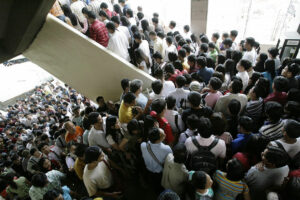THE growth outlook for the Philippines has improved due to the reopening of the economy and the incoming government’s apparent commitment to significant investment, but food inflation threatens to dampen the recovery, analysts said.
Moody’s Analytics said in a note that first quarter gross domestic product (GDP) came in stronger than expected, with more momentum promised after the lifting of mobility restrictions and capacity limits on many establishments.
The note, “APAC Outlook: Resilience, So Far,” Moody’s Analytics noted a pickup in Philippine domestic consumption growth.
“Exports have been supportive as elsewhere in the region. Policy statements from President-elect Ferdinand Marcos, Jr. indicate that infrastructure investment will accelerate as the focus returns to the ‘Build, Build, Build’ policies of the Duterte administration,” Moody’s Analytics said.
GDP growth accelerated to 8.3% in the first quarter, a turnaround from the 3.8% contraction a year earlier.
Sonia Zhu, associate economist at Moody’s Analytics, told BusinessWorld: “Moody’s Analytics has upwardly revised 2022 full year GDP growth forecast to 7.2% in June but much of this year’s growth was front-loaded in the first quarter due to a stronger-than-expected performance. The accelerated domestic consumption growth since the easing of social restrictions has supported first-quarter growth. However, entrenched inflation and the pace of monetary policy tightening add to uncertainty and risk. Moody’s Analytics made slight downward adjustments to second and third quarter GDP growth.”
For its part, Nomura Global Markets Research said one specific drag on the recovery is the rising cost of food.
In a note, “Asia: Food inflation — who is most at risk?” the Philippines was tagged as among the most vulnerable to higher food prices due to the high consumer price index (CPI) weighting for food and its dependence on food imports.
“Our more granular analysis shows that Hong Kong, Singapore, the Philippines and South Korea are the most exposed, as they are large net importers of most food categories,” Nomura Global Markets said.
The CPI basket of goods has a nearly 39% weighting for food, according to the Philippine Statistics Authority. Households in poor countries tend to devote a larger share of their spending on food.
Net food imports account for over 2% of GDP, second-highest in the region after Hong Kong, Nomura Global Markets said.
“The recent rise in food price inflation was initially led by rising prices of corn and fruit but is now being exacerbated by higher sugar and vegetable oil prices, reflecting global supply conditions that have tightened since the Russia-Ukraine conflict and the emergence of protectionist policies, such as export bans of palm oil by Indonesia and sugar by India,” Nomura Global Markets said.
“We expect these factors to continue driving food price inflation higher, alongside rising fertilizer/feedstock costs and surging energy prices,” Nomura Global Markets economists Euben Paracuelles and Rangga Cipta said. — Keisha B. Ta-asan
